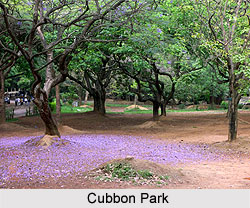 Cubbon Park is a landmark "lung" area of the city of Bengaluru, in the Indian state of Karnataka, situated in the heart of city in the Central Administrative Area. The park was built in the year 1870, when Major General Richard Sankey was the then British Chief Engineer of Mysore state, it covered an area of 100 acres and subsequent extension has taken place and the area reported now is about 300 acres.
Cubbon Park is a landmark "lung" area of the city of Bengaluru, in the Indian state of Karnataka, situated in the heart of city in the Central Administrative Area. The park was built in the year 1870, when Major General Richard Sankey was the then British Chief Engineer of Mysore state, it covered an area of 100 acres and subsequent extension has taken place and the area reported now is about 300 acres.
The park has a rich history of plentiful plantation of fauna and flora coupled with a lot of inspiring and aesthetically positioned statues and buildings of famed celebrities, in its precincts. This particular park was first named as "Meade`s Park" after Sir John Meade, the acting Commissioner of Mysore in 1870 and subsequently renamed as Cubbon Park after the longest serving commissioner of the time, Sir Mark Cubbon. In the year 1927, to honour the Silver Jubilee of Sri Krishnaraja Wodeyar`s rule in Mysore State, the park was again renamed as "Sri Chamarajendra Park", in memory of the 19th Century ruler of the state Sri Chamarajendra Wodeyar (1868 - 94) during whose rule the park came into being.
In the year 1927, to celebrate the twenty five years rule of Sri Krishnaraja Wodeyar in Mysore State the park was renamed as Sri Chamarajendra Park in memory of the 19th Century ruler of the state Sri Chamarajendra Wodeyar during whose rule the park came into being. The landscaping in the park artistically put together natural rock outcrops with thickets of trees, enormous bamboos, with grassy area and flowerbeds and the tombstones within its limits, taken care of the Horticulture Department of the Government of Karnataka. The predominantly green area of the park has many motorable roads, and the well laid out walking paths running through the park is frequented by early morning walkers and the naturalists who study plants in the tranquil natural environment.
Tourists visiting this Park in the city of Bengaluru have nicknamed the city itself as `Garden City`. The importance of the Park to the city`s environment is best stated by two Urban Architects who have won the national competition to design `Freedom Park.`
Flora and Fauna of Cubbon Park
Exotic and rare botanical species are found in the park are about 68 genera and 96 species with a total of around 6000 plants/trees. Native species found in the park are: Artocarpus, Cassia Fistula, Ficus, Polyalthias etc., and striking species like Araucaria, Bamboo, Castanospermum Australe, Grevillea Robusta, Millettia, Peltophorum, Schinus Molle, Swietenia Mahagoni, Tabebuia etc.
Amongst the ornamental and flowering exotic trees lining the roads in the park are the Grevillea Robusta (Silver Oak)-the first oaks introduced to Bengaluru from Australia - and the Delonix or the Gulmohar tree (bright red flowers with long petals) along the Cubbon road in the park, which is a widely cultivated tropical ornamental tree around the world.



















